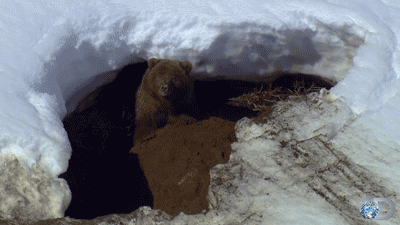If You Don’t Use Your Bones, You Lose Them—Unless You’re a Hibernating Bear
A weekly roundup of the best in science journalism, doodled.

During its long winter’s nap, a bear’s bones remain summer-strong.
Bones seem pretty solid and stable, but they’re actually in constant flux, as our skeletons regularly replace old tissue. As your bones absorb the physical impacts of your movements, they form new tissue, which is why exercise helps keep bones strong. So how is it that bears can just lie around all winter and not get brittle bones come spring?

In a recently published study, scientists took blood samples from bears over four hibernation seasons and discovered that their bodies basically put the bone-remodeling process on hold. They also found that during their long sleep, calcium amounts in their bones remain level, preventing bone loss.

This allows bears to emerge from their dream dens ready to party. The research might also have implications for degenerative bone problems in humans—and, possibly, for astronauts living a low-impact life as they float around in space.
As seabird numbers crash across the globe, a dramatic disappearance on one Florida island leaves scientists stumped.

Seabirds depend on healthy oceans. They spend their long lives traveling all over the sea and eating all kinds of critters. So when seabird populations are struggling, it likely means that ocean ecosystems are off-kilter. According to scientists from the University of British Columbia, this is just what’s happening. In a recent study published in Plos One, they found that monitored seabird populations all over the world have declined by 70 percent since 1950.
That comes to a loss of about 230 million birds over 60 years, and the suspected causes are all human-created: declines in the fish that these birds rely on for food, climate change, plastic pollution, harmful fishing gear, and new predators, such as invasive rats that attack bird nests.

ThinkProgress reports that the study’s release comes days after U.S. Fish and Wildlife officials expressed concern over the sudden disappearance of tens of thousands of birds that usually nest at this time of year in a wildlife refuge off the coast of Florida. This spring, the birds, including snowy egrets and tricolored herons, came back to the island per usual in April but disappeared in May, leaving large numbers of eggs unhatched. The mass disappearance is an unprecedented event in terms of the number and diversity of birds that fled all at once—and officials still don’t why.
A microbe that lives in our guts can turn emissions into ethanol.

Most microbes live off sugar, but the oldest microbes on earth consume gases like carbon monoxide, methane, and hydrogen sulfide, which are emitted by the hydrothermal vents that these gas-fermenting microorganisms often call home—AND by steel plants.

The steel industry produces carbon monoxide as a by-product, which is a big contributor to ground-level ozone. It usually gets rid of the gas by burning it, converting it to carbon dioxide (a big contributor to climate change). So innovators at the Chicago-based biotechnology firm LanzaTech have turned to a microbe from the Clostridium genus for an ancient, natural technology to reduce a steel plant’s pollution. Found in sewage, soil, and marine sediments, as well as human and animal intestines, these bacteria feed on carbon monoxide and turn it into ethanol.
A pilot project is slated to start cranking out ethanol at the world’s largest steel manufacturer, ArcelorMittal, in Belgium later this year. The goal is to eventually produce 47,000 tons of this clean-burning fuel a year.
The answers are always in nature, aren’t they?
Climate scientists are really sad (but they’re not supposed to tell you that).


I’m not going to pretend this recent Esquire piece, which got personal with climate scientists who are depressed because they know too much about the fate of our planet, was a blast to read. But I do think it’s an important read. The media seems to be stuck in a loop: We’re not talking about worst-case scenarios because people don’t want to read about worst-case scenarios. But if the public doesn’t know how bad things could get, will they be motivated to demand action from their elected leaders?

Writer John H. Richardson speaks with a number of outspoken scientists-turned-advocates, like Michael E. Mann, Jason Box, and Gavin Schmidt, a climatologist for NASA. After admitting that his work is keeping him awake at night, Box told Richardson, “The shit that's going down has been testing my ability to block it [out]."
Acknowledging the potential catastrophes we’re in for is upsetting, to say the least. But sometimes we chair-sitting, cat-meming softies need to suck it up and make a little date with the other end of the reality spectrum.
This article was originally published on onEarth, which is no longer in publication. onEarth was founded in 1979 as the Amicus Journal, an independent magazine of thought and opinion on the environment. All opinions expressed are those of the authors and do not necessarily reflect the policies or positions of NRDC. This article is available for online republication by news media outlets or nonprofits under these conditions: The writer(s) must be credited with a byline; you must note prominently that the article was originally published by NRDC.org and link to the original; the article cannot be edited (beyond simple things such grammar); you can’t resell the article in any form or grant republishing rights to other outlets; you can’t republish our material wholesale or automatically—you need to select articles individually; you can’t republish the photos or graphics on our site without specific permission; you should drop us a note to let us know when you’ve used one of our articles.

How to Make an Effective Public Comment
From Dams to DAPL, the Army Corps’ Culture of Disdain for Indigenous Communities Must End
How to Become a Community Scientist